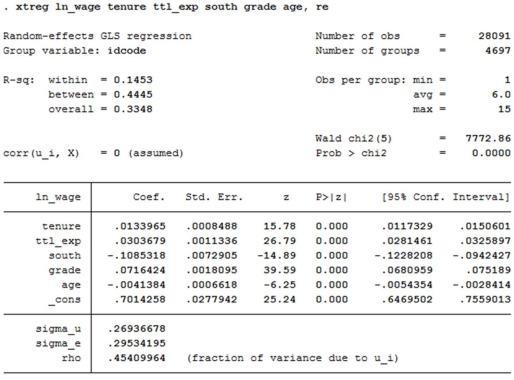Using the National Longitudinal Survey of young women who were 14-26 years in 1968 with independent variables age (age in current year),grade (current grade completed),south (1 if south),ttl_exp (total work experience),tenure (job tenure,in years),and the dependent variable ln_wage (natural log of wage/GNP deflator).You obtain the following pooled cross section results in STATA. 
a)Comment on the coefficient estimates and the statistical significance of the estimates.What type of model is this? What are the drawbacks of estimating this type of model?
You then estimate a fixed effects model in STATA and obtain the following results 
b)Explain how a fixed effects model is estimated and in what circumstances fixed effects models are the most appropriate option.Be specific.
c)How do these results differ from the results in part a?
d)Why was grade dropped? Be specific.
Finally,you estimate a fixed effects model in STATA and obtain the following results 
e)Explain how a random effects model is estimated and in what circumstances random effects models are the most appropriate option.Be specific.
f)Why is grade not dropped from this specification but it was dropped for the fixed effects model?
g)Which of the three models do you prefer? Why?
Correct Answer:
Verified
View Answer
Unlock this answer now
Get Access to more Verified Answers free of charge
Q19: The biggest difference between fixed-effects and random-effects
Q20: Panel data differs from cross-section data in
Q21: What is a random-effects model? How do
Q22: Suppose that in an effort to explain
Q23: What is a first-differenced model? How is
Q25: Suppose that in an effort to explain
Q26: What is a fixed-effects model? How do
Q27: Suppose that in an effort to explain
Q28: What is a pooled cross-section model? For
Q29: Suppose that in an effort to
Unlock this Answer For Free Now!
View this answer and more for free by performing one of the following actions

Scan the QR code to install the App and get 2 free unlocks

Unlock quizzes for free by uploading documents